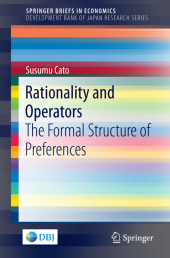 Neuerscheinungen 2016Stand: 2020-02-01 |
Schnellsuche
ISBN/Stichwort/Autor
|
Herderstraße 10
10625 Berlin
Tel.: 030 315 714 16
Fax 030 315 714 14
info@buchspektrum.de |

Susumu Cato
Rationality and Operators
The Formal Structure of Preferences
1st ed. 2016. 2016. ix, 124 S. 1 SW-Abb. 235 mm
Verlag/Jahr: SPRINGER, BERLIN; SPRINGER SINGAPORE 2016
ISBN: 9811018952 (9811018952)
Neue ISBN: 978-9811018954 (9789811018954)
Preis und Lieferzeit: Bitte klicken
This unique book develops an operational approach to preference and rationality as the author employs operators over binary relations to capture the concept of rationality.
A preference is a basis of individual behavior and social judgment and is mathematically regarded as a binary relation on the set of alternatives. Traditionally, an individual/social preference is assumed to satisfy completeness and transitivity. However, each of the two conditions is often considered to be too demanding; and then, weaker rationality conditions are introduced by researchers. This book argues that the preference rationality conditions can be captured mathematically by "operators," which are mappings from the set of operators to itself. This operational approach nests traditional concepts in individual/social decision theory and clarifies the underlying formal structure of preference rationality.
The author also applies his approach to welfare economics. The core problem of ´new welfare economics,´ developed by Kaldor, Hicks, and Samuelson, is the rationality of social preference. In this book the author translates the social criteria proposed by those three economists into operational forms, which provide new insights into welfare economics extending beyond ´new welfare economics.´
1 Introduction.- 1.1 The Aim of This Book.- 1.2 Rationality of Preference.- 1.3 An Operational Interpretation of Theorems of Welfare Economics.- 1.4 What Can the Operational Approach Achieve?.- 1.5 A Historical Perspective.- 1.6 The Structure of This Book.- 2 Preferences and Operators.- 2.1 Introduction.- 2.2 Binary Relations.- 2.3 Basic Results on Operators.- 2.4 Closure Operators.- 2.5 Concluding Remarks.- 3 Rationality and Operators.- 3.1 Introduction.- 3.2 Properties of Binary Relations.- 3.3 Choice Functions.- 3.4 Extensions.- 3.5 Concluding Remarks.- 4 Operations over the Set of Binary Relations.- 4.1 Introduction.- 4.2 Basic Results.- 4.3 Direct Operations over the Set of Binary Relations.- 4.4 Indirect Operations over the Set of Binary Relations.- 4.5 Concluding Remarks.- 5 Application to Welfare Economics.- 5.1 Introduction.- 5.2 Setting.- 5.3 Paretian Welfare Economics.- 5.4 The Kaldor-Hicks Compensation Principle.- 5.5 Bergsonian-Samuelson Approach of Welfare Economics.- 5.6 Concluding Remarks.- 6 Conclusion: Beyond Ordinal Operators.- 6.1 More Applications.- 6.2 Operators for Ordinal Preferences.- 6.3 Operators for Cardinal Preferences.- 6.4 Final Remarks.- Index.


